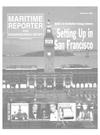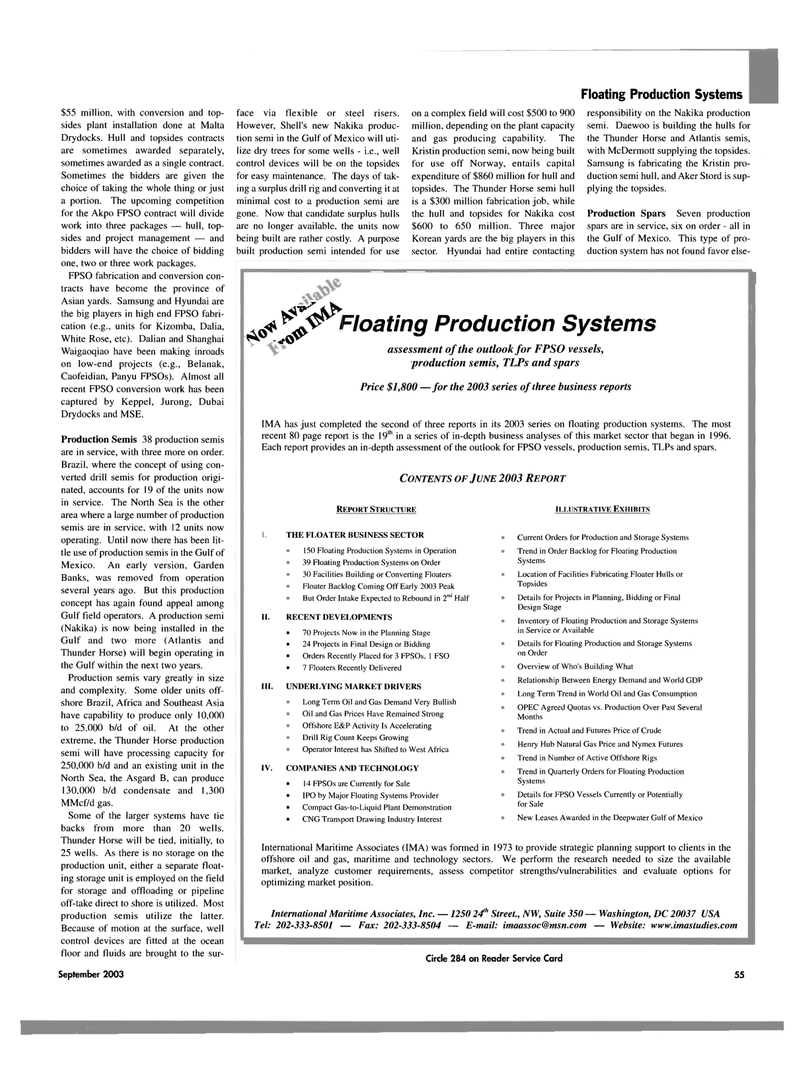
Page 55: of Maritime Reporter Magazine (September 2003)
Read this page in Pdf, Flash or Html5 edition of September 2003 Maritime Reporter Magazine
$55 million, with conversion and top- sides plant installation done at Malta
Drydocks. Hull and topsides contracts are sometimes awarded separately, sometimes awarded as a single contract.
Sometimes the bidders are given the choice of taking the whole thing or just a portion. The upcoming competition for the Akpo FPSO contract will divide work into three packages — hull, top- sides and project management — and bidders will have the choice of bidding one, two or three work packages.
FPSO fabrication and conversion con- tracts have become the province of
Asian yards. Samsung and Hyundai are the big players in high end FPSO fabri- cation (e.g., units for Kizomba, Dalia,
White Rose, etc). Dalian and Shanghai
Waigaoqiao have been making inroads on low-end projects (e.g., Belanak,
Caofeidian, Panyu FPSOs). Almost all recent FPSO conversion work has been captured by Keppel, Jurong, Dubai
Drydocks and MSE.
Production Semis 38 production semis are in service, with three more on order.
Brazil, where the concept of using con- verted drill semis for production origi- nated, accounts for 19 of the units now in service. The North Sea is the other area where a large number of production semis are in service, with 12 units now operating. Until now there has been lit- tle use of production semis in the Gulf of
Mexico. An early version, Garden
Banks, was removed from operation several years ago. But this production concept has again found appeal among
Gulf field operators. A production semi (Nakika) is now being installed in the
Gulf and two more (Atlantis and
Thunder Horse) will begin operating in the Gulf within the next two years.
Production semis vary greatly in size and complexity. Some older units off- shore Brazil, Africa and Southeast Asia have capability to produce only 10,000 to 25.000 b/d of oil. At the other extreme, the Thunder Horse production semi will have processing capacity for 250,000 b/d and an existing unit in the
North Sea, the Asgard B, can produce 130.000 b/d condensate and 1,300
MMcf/d gas.
Some of the larger systems have tie backs from more than 20 wells.
Thunder Horse will be tied, initially, to 25 wells. As there is no storage on the production unit, either a separate float- ing storage unit is employed on the field for storage and offloading or pipeline off-take direct to shore is utilized. Most production semis utilize the latter.
Because of motion at the surface, well control devices are fitted at the ocean floor and fluids are brought to the sur-
September 2003 face via flexible or steel risers.
However, Shell's new Nakika produc- tion semi in the Gulf of Mexico will uti- lize dry trees for some wells - i.e., well control devices will be on the topsides for easy maintenance. The days of tak- ing a surplus drill rig and converting it at minimal cost to a production semi are gone. Now that candidate surplus hulls are no longer available, the units now being built are rather costly. A purpose built production semi intended for use on a complex field will cost $500 to 900 million, depending on the plant capacity and gas producing capability. The
Kristin production semi, now being built for use off Norway, entails capital expenditure of $860 million for hull and topsides. The Thunder Horse semi hull is a $300 million fabrication job, while the hull and topsides for Nakika cost $600 to 650 million. Three major
Korean yards are the big players in this sector. Hyundai had entire contacting
CONTENTS OF JUNE 2003 REPORT
Floating Production Systems responsibility on the Nakika production semi. Daewoo is building the hulls for the Thunder Horse and Atlantis semis, with McDermott supplying the topsides.
Samsung is fabricating the Kristin pro- duction semi hull, and Aker Stord is sup- plying the topsides.
Production Spars Seven production spars are in service, six on order - all in the Gulf of Mexico. This type of pro- duction system has not found favor else-
I ^ ^^Floating Production Systems assessment of the outlook for FPSO vessels, production semis, TLPs and spars
Price $1,800 — for the 2003 series of three business reports
IMA has just completed the second of three reports in its 2003 series on floating production systems. The most recent 80 page report is the 19,h in a series of in-depth business analyses of this market sector that began in 1996.
Each report provides an in-depth assessment of the outlook for FPSO vessels, production semis, TLPs and spars.
REPORT STRUCTURE ILLUSTRATIVE EXHIBITS
THE FLOATER BUSINESS SECTOR 150 Floating Production Systems in Operation 39 Floating Production Systems on Order 30 Facilities Building or Converting Floaters
Floater Backlog Coming Off Early 2003 Peak
But Order Intake Expected to Rebound in 2n<1 Half
II. RECENT DEVELOPMENTS • 70 Projects Now in the Planning Stage • 24 Projects in Final Design or Bidding • Orders Recently Placed for 3 FPSOs, 1 FSO • 7 Floaters Recently Delivered
III. UNDERLYING MARKET DRIVERS
Long Term Oil and Gas Demand Very Bullish
Oil and Gas Prices Have Remained Strong
Offshore E&P Activity Is Accelerating
Drill Rig Count Keeps Growing
Operator Interest has Shifted to West Africa
IV. COMPANIES AND TECHNOLOGY • 14 FPSOs are Currently for Sale • IPO by Major Floating Systems Provider • Compact Gas-to-Liquid Plant Demonstration • CNG Transport Drawing Industry Interest
Current Orders for Production and Storage Systems
Trend in Order Backlog for Floating Production
Systems
Location of Facilities Fabricating Floater Hulls or
Topsides
Details for Projects in Planning. Bidding or Final
Design Stage
Inventory of Floating Production and Storage Systems in Service or Available
Details for Floating Production and Storage Systems on Order
Overview of Who's Building What
Relationship Between Energy Demand and World GDP
Long Term Trend in World Oil and Gas Consumption
OPEC Agreed Quotas vs. Production Over Past Several
Months
Trend in Actual and Futures Price of Crude
Henry Hub Natural Gas Price and Nymex Futures
Trend in Number of Active Offshore Rigs
Trend in Quarterly Orders for Floating Production
Systems
Details for FPSO Vessels Currently or Potentially for Sale
New Leases Awarded in the Deepwater Gulf of Mexico
International Maritime Associates (IMA) was formed in 1973 to provide strategic planning support to clients in the offshore oil and gas, maritime and technology sectors. We perform the research needed to size the available market, analyze customer requirements, assess competitor strengths/vulnerabilities and evaluate options for optimizing market position.
International Maritime Associates, Inc. — 1250 24th Street., NW, Suite 350 — Washington, DC 20037 USA
Tel: 202-333-8501 — Fax: 202-333-8504 — E-mail: [email protected] — Website: www.imastudies.com
Circle 284 on Reader Service Card 55

 54
54

 56
56
